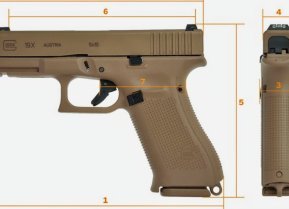The Nazi's FG-42 Rifle Was Born from the Depths of Defeat
The rifle was used in Italy, France, Bosnia, and in defense of Berlin as the Nazi government was collapsing under Allied forces.
The German arms industry has always been a fairly robust and advanced one. From Mauser to HK, it is often ahead of the game. This was very true during World War II when the Nazi forces made numerous advances in firearms and warfare including the first assault rifle and the first general-purpose machine gun. Along that route, we also got a firearm with a unique design and interesting legacy: the FG-42.
The FG-42 was developed as a result of the Battle of Crete. It doesn’t fall into a typical firearms category. It could be considered a battle rifle, but also an automatic rifle. It has a bullpupish design, it’s not necessarily a carbine, and it isn’t a machine gun, either. The FG-42 was a specific product made for a specific purpose that guided the design of this oddball weapon.
THE BATTLE OF CRETE LEADS TO FG-42’S DEVELOPMENT
Airborne infantry was first used during World War II. In Germany, the airborne infantry was part of the Luftwaffe. During jumps, the Nazi forces were only armed with pistols and hand grenades. Their rifles, submachine guns, crew-served machine guns, and anti-armor weapons were dropped separately from the aircraft.
A soldier armed with just a handgun isn’t capable of doing much fighting. The idea was that the airborne infantry could find their gear and get into the fight quickly.
But during the Battle of Crete, which was the first major-scale operation using airborne infantry, this idea proved to be disastrous.
The Commonwealth and Greek defenders were dug in and armed with rifles and machine guns. As the Germans scrambled to find their weapons, the defenders poured fire on them. This resulted in heavy casualties and almost allowed the defenders to win the battle.
This disastrous operation sidelined the paratroopers. Nazi high command was not interested in further deployment and considered shifting them to the regular infantry. However, this also forced the Luftwaffe to begin the development of the FG-42.
AN AIRBORNE-DRIVEN WEAPON
FG stands for Fallschirmjäger, which in German means parachute infantry and 42 commemorates the year the weapon was adopted. The rifle was to be a shoulder-fired automatic rifle that could replace bolt-action rifles, submachine guns, and light machine guns. Development was done entirely by the Luftwaffe because the German army had dismissed the entire idea as unrealistic.
The Luftwaffe developed the LC-6 specification to guide the development of the rifle, which stated that the rifle must be no longer than 39.4 inches and not much heavier than the Kar 98K rifle so paratroopers could jump with it. On top of that, the rifle must be capable of firing from the closed bolt in semi-auto but from the open bolt when toggled to full-automatic. The rifle needed to fire the 8mm Mauser round from a detachable magazine. Additionally, Luftwaffe still wanted the gun to use a bayonet and be capable of firing rifle grenades.
After several prototypes and variants, Luftwaffe got a rifle that met the requirements of the LC-6 specification and the FG-42 was born. The FG-42 used side-mounted magazines and had a number of extra features, including a folding set of bipods as well as the ability to accept optics. Germans fielded the gun with fixed four-power optics on occasion.
HOW DID THE WEAPON PERFORM?
The FG-42 gave the paratroops a unique rifle that they could jump with. Once on the ground, the weapon provided them with long-range, powerful capabilities. The weapons could be used as semi-auto rifles or in a squad support role to lay down automatic fire.
In action, the rifle featured a muzzle brake and a buffered stock which reduced recoil significantly. This made the gun easy to control when fired fully automatic at the enemy. Later models, known as Type G guns, featured a gas regulator which allowed for reliable feeding with a multitude of ammo types and qualities.
Although this was not a mass-produced weapon, paratroops deployed with it throughout the war, and was also used by the German troops that rescued Mussolini.
The rifle was used in Italy, France, Bosnia, and in defense of Berlin as the Nazi government was collapsing under Allied forces. The rifle seemingly performed well for its purpose. Admittedly several design changes were made to accommodate material shortages as they arose, but the rifle soldiered on until we kicked Hitler and the rest of his Nazi buddies in the ass.
LEGACY OF THE FG-42
The FG-42 saw no additional development after WWII as no one wanted to continue with such an odd rifle. However, some of the parts and pieces of the rifle went on to influence other guns. The U.S. used some of the weapon’s engineering in the M60 machine gun and Switzerland took some inspiration from the FG-42 to develop the Sturmgewehr 52 rifle. But the FG-42 remains somewhat lost to time.
About the Author
Travis Pike is a former Marine Machine gunner who served with 2nd Bn 2nd Marines for 5 years. He deployed in 2009 to Afghanistan and again in 2011 with the 22nd MEU(SOC) during a record-setting 11 months at sea. He’s trained with the Romanian Army, the Spanish Marines, the Emirate Marines, and the Afghan National Army. He serves as an NRA certified pistol instructor and teaches concealed carry classes.
This article was first published by Sandboxx News.


